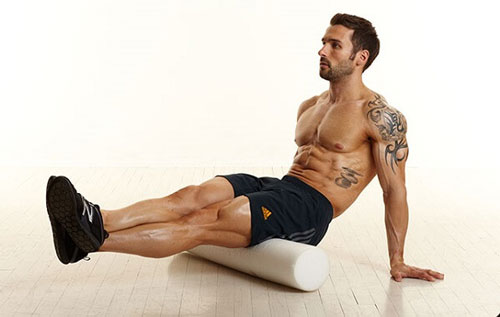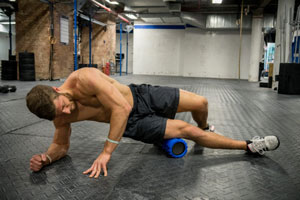This article looks at the pros and cons of using a foam roller on the lower back. Stick around for some useful exercise techniques for the back, neck, shoulders and legs. For a complete foam roller guide see our Foam Roller FAQ page.
Now to get on-topic.
Should you use a foam roller before, during or after you exercise? Does it actually work? Is it for recovery or for during your routine? Is a foam roller good for back pain? Read on to find answers to all those questions.
If you think foam rolling was just for light exercise routines, post workout or the day after to reduce DOMS and to induce rehabilitation of battered muscle cells think again. Powerlifters and event strongman can be seen using foam rollers before lifting massive poundages.
It is extremely beneficial to incorporate foam rolling into bodybuilding and general progressive resistance weight training. Especially also on heavy days.
Imagine having your own masseuse right at you fingertips. Or masseur if you prefer.
Adding in BCAA’s to intense training sessions and foam rolling can relieve soreness and improve blood circulation which enhances recovery. But is this just broscience or the product of gossiping at your local supplement shack or gym?
Heavy Duty Powerlifters Using Foam Rollers
Andy Bolton, British strongman and powerlifter, who still holds the biggest squat record in the world (550kg/1213lbs!), and who was the first man to deadlift over 1000 pounds, in his squat, deadlift and bench press training programs talks about foam rolling and stretching, to help prepare him for massive lifts.
I talked with him at a seminar in Belfast and this is a guy who would not waste time on something unless it actually worked. It’s official foam rolling is not for softies!
So what does foam rolling do? Foam rolling is a form of self massage. You can work on trigger points, or knots in the muscles and release them and basically loosen up.
It can help you regain and retain flexibility by improving muscle elasticity. The technical term is self-myofascial release.
It is useful before and during exercise routines to prepare and free up your muscles so they can perform and explode with greater force and freedom, especially on demanding lifts. Foam rolling is also an excellent way to help repair your muscles in the days after you train. If you like torture make sure to use a roller with protruding edges. I find it excellent for deep tissue massage.
Here’s mine:

I have one and it is a world of pain…. They do help relieve pressure and reduce stiffness and muscle soreness, but only after creating a lot of pain first!
Is Foam Rolling Bad For Your Joints?
Yes definitely if done incorrectly, or used on an injury, especially on the lower back. It can damage the discs and do more harm than good. Foam rolling is for soft tissue and not for exposed bones like you find on the lumbar spine. The upper back can be ok unless you have a clinical diagnosis, but the lower spine can be extremely problematic especially if you have stenosis, slipped, bulging or ruptured discs, restricted movement, lower back pain, arthritis and osteoporosis or any other spinal deformity or disease.
Some people who have good mobility and no problems with their lower back will roll away on this region. I have lower back wear on tear on my L1 & L2 discs, and anytime i use a roller here it is uncomfortable. There is a lot of views on whether foam rolling this area if you have a sound back is good or bad. Personally for this area i like to err on the side of caution and avoid it.
If you are going to experiment foam rolling the lower back i suggest you use a thinner foam roller and proceed with caution cause this region of the body is quite tender. Take it easy as you will read below and see if you watch the video that your spine is naturally arched and supporting your lower back on a foam roller arches it to an even more extreme angle. Ye-oouch – I can hear discs popping!
Foam Rolling The Lower Back
Foam rolling the lower back can lead to an overarching or over extension of the lumbar spine. As there is a natural curve in a healthy spine, further extension on this plane of motion can be extremely damaging. It is wiser to foam roll the areas surrounding the lower back- the glutes, quadriceps, hip flexors, hamstrings and the upper back, as these areas are key to maintaining the spine and play a massive part in the flexibility of your upper and lower back.
If you are like me and have injured your spine on too many occasions to mention (desk job for years combined with lower back defects…), or just feel stiff a lot of the time, you will probably notice your hamstrings tightening up like a vice. It’s the body and brains way of protecting itself from further injuries, it tightens up and restricts movement in this area, fearing further damage.
Using A Lacrosse Ball For Deep Tissue Massage
If you work a foam roller on your hams and glutes and stretch the hams when you have a sore lower back, you will regain a ton more flexibility and mobility and reduce the pain in as little as 10 mins. If you want to go for the ultimate pain burn and unlock your hamstrings once they tighten up place a lacrosse ball under your hamstring and rock back on forwards on it.
My wife and kids often see me performing this on the kitchen table and think i’m performing some kind of torture routine with the yelps and hollers i let out. I love it really.
A super-tip for foam rolling when you experience tightness or soreness or if you are using a lacrosse ball is to massage the area above and below the offending region. If you experience pain in the mid thigh, massage the upper quad and lower teardrop region (just above knee) as the offending muscle fibres could be hiding there.
Safe Foam Rolling Exercises For The Back
Rolling a foam roller on the lats (one of the largest muscles on the body) is a safe place to use a foam roller. If you roll all the way up to the top of your lats you can also relieve muscle tension and increase flexibility in the rotator cuff region of the shoulder where the lats and shoulder region intersect.
To begin lie on your side and place your pinky on the ground and thumb in the air with your palm facing outwards- just copy the picture!
Roll slowly from the upper to lower lat region until you find any pain or stiff trigger points. Hold pressure on any that you find for between 30 and 90 seconds. The trick is not to cause pain or push your weight too hard into the roller – gravity and your body weight will already be doing this. Repeat on both sides.
You can also start just under the shoulder and push forward and backwards across the foam roller (keeping it static). You can work on smashing any tight areas and releasing those tense muscle fibres. Once you find any tense spots work around them slowly inch by inch, and adjust your position an inch or 2 to the left or right, and up and down, and release the surrounding patches of tissue.
Areas worked:
Back Muscles
lower latissimus dorsi
Shoulder Muscles
Foam Rolling The Upper Back

A foam roller is quite useful on the upper back. You can also flip it sideways instead of using it horizontally. You naturally will work into the neck, traps and shoulder when rolling the upper back. Drop your hips to the floor before you start.
Raising the hips causes your abs to engage which will restrict the range of movement in your back and make it hard for you to niggle out the tight spots.
In it’s simplest form you can place a roller on the ground and place your upper back on it and roll up and down from just below the neck to the mid back. You can isolate specific areas and get better results if you experiment with your hand positions. Crossing them over, then folding the arms in front of the chest.
Don’t start with arms folded behind neck as this will decrease the range at which you can arch your back, and limit your range of motion. Thus making it hard to work your entire back and flush out tense spots. You can cross them behind the neck at the end.
This also can be done up against a wall.
Here is Jeff from Athlene X combining foam rolling with a thoracic spine mobility drill.
Areas worked:
Upper Back
Lats
Shoulders
Foam Rolling The Neck
https://gfycat.com/oldfashionedunpleasantclownanemonefish
There are a couple of ways you can roll out the tension in your neck. I have experimented with various methods as i have an extremely tight neck, due to disc issues and wrestling/bjj training.
No need to roll directly up and down the bones of the neck. Like the video above method 1 goes like this.
Technique 1
Rest the nape of your neck on foam roller, slowly turn to the left and then go back to the center. Repeat on the right side.
Pause on any spots where you feel tightness. Apply light pressure (backwards/sidewards), unless it is painful.
Technique 2
Lie on the roller like above but this time elevate your hips. Don’t roll like on technique 1 (i know contrary to the foam roller). Like before simply slowly turn to the left, back to the center and turn to the right.
Hold pressure on any tight areas. Lower your hips and relax. Go easy on this one.
Foam Rolling The Hamstrings
Foam rolling the hamstrings can be an excellent therapy for relieving back pain. It may not make you pain-free but it can loosen up the hamstrings and create less of a coil in this area so you feel more fluid and have a wider degree of mobility. Tight hamstrings are a precursor to back pain.
They create drag on the lumbar spine causing the pelvis to rotate and rise backwards- known as anterior pelvic tilt (exacerbated by sitting excessively and inactive lifestyles). Your pelvis was not designed to be this way, and many studies have indicated that this affects posture throughout the whole of your body as the pelvis is the center of the torso.
Technique
Foam rolling the hamstrings is quite easy. You can do it with one legged crossed over the ankles like the pic above or even cross one leg over above the knees. You can also do it without the legs crossed. I like to work one leg at a time.
Place you hands on the ground and the foam roller under 1 or both legs. Roll up and down slowly from just below the glutes to the knee and hold pressure or roll slowly over pain points.
I even like to lean in on the foam roller rocking side-to-side and angle my way into it and roll diagonally up and down.
When using one leg you can bend the other at the knee.
TIP – as the glutes, quads and hips interlink with the hamstrings it’s worth rolling these as well to eliminate any stiffness. Muscle swelling seems to travel so it will do no harm rolling your entire leg, working the calf, hamstrings, glutes and hips flexors and spending a few minutes on each section.
Foam Rolling The Quads
Tight quads are not just the forte of runners, football players, gym rats or track and field stars. If you haven’t been in a gym for a while, or have an executive or admin job, or drive a lot, you most likely have tight hams and quads.
Technique
Lie on the floor with your quads resting on your foam roller and assume a press up position.
Roll up and down from the hip to the knee, pausing at any pain spots. Titling side to side and press holding over trouble spots is good.
https://gfycat.com/vigorouswiltedaustraliankestrel
You can experiment on the side of the quad like here- be warned, it is quite painful. This works the IT band area- and many people believe you should not use a foam roller here. You can read about it on our FAQ page.
Tip – I prefer using one leg at a time. After you get more friendly with you roller, you will be able to pinpoint tight areas more intuitively. It’s the old bodybuilding mantra- the mind-muscle connection.
Areas Worked:
Quads
Hip Flexors
Does Foam Rolling Decrease Muscle Gains?
If you are in the hardcore heavy weight training fraternity and you think foam rolling can decrease your strength or is a waste of time, refer to the top of the post about World Champion power lifter Andy Bolton. Or read this scientific study by the Journal of Strength and Conditioning Research that finds no link between a weakening of strength and foam rolling.
Foam rolling was showing to increase the participants range of motion in this study. If you have a greater range of motion and rolling with foam is restoring your muscles to their native form, how could this be bad for strength?
Don’t Roll Long Until You Work Out The Knots
Just like you press the bumps out dough before rolling your bread, it’s more effective to apply downwards pressure on any bumps or knots (technical term= adhesions) in your muscles before rolling them out. If not they will still be there and foam rolling will be a waste of your precious time.
There is no point rolling for 30 minutes neither, if you still have pain or severe sensitivity once you have rolled for a few minutes on one area it’s time to see the physio, as something else is wrong. Perhaps you have a severe muscle strain. Excessive foam roller work will only aggravate the area, so learn when it’s time to back off.
Foam Rolling Can Be Effective Against Cellulite
Yes I know this article is starting to sound like foam rolling is a miracle cure, which it isn’t, but there is research that shows foam rolling can be an effective treatment for reducing the appearance of cellulite. Combined with diet, and fat reduction, it makes sense that you can improve the condition of your skin with myofascial release techniques.
Read our post here about how foam rolling can reduce the appearance of cellulite.





